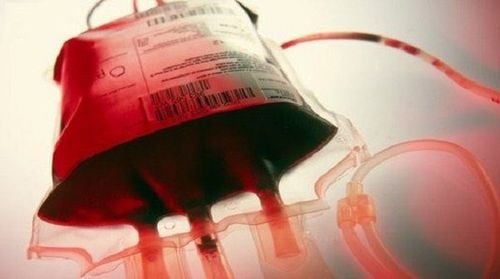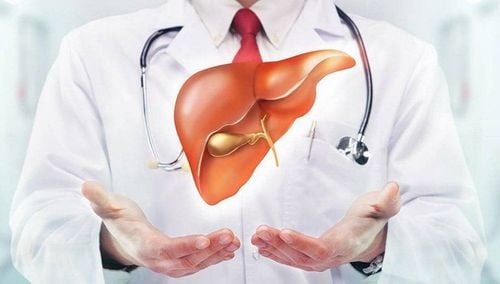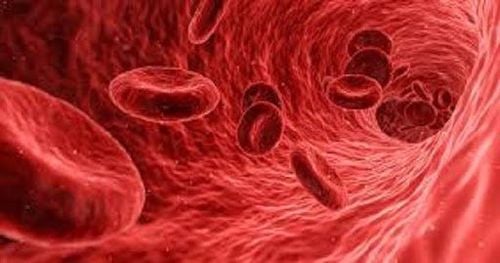This is an automatically translated article.
The article was written by a doctor of Hematology - Blood Transfusion - Laboratory Department - Vinmec Ha Long International General Hospital.
Blood and blood products are special drugs of human origin, used to replace lost blood in recipients and correct abnormalities in the blood without any solution. that's okay. Blood is used in the treatment of most medical specialties. Having new blood can develop many high techniques. Blood demand using blood represents the development of Medicine.
1. What is an adverse event related to blood product transfusion?
Unexpected complications or blood transfusion reactions are reactions and manifestations that occur in patients related to blood transfusion and blood products.
Blood transfusion/blood product complications can occur early or late. Therefore, only blood transfusion when absolutely necessary.
Complications occur early such as hemolysis due to wrong blood type ABO, Rh, hypothermia, tremor, allergies, acute pulmonary edema during transfusion... Late complications occur during blood transfusion include: infection , infection with viruses that cause blood-borne diseases such as hepatitis B, C, HIV, late hemolysis...
When an accident occurs, it should be handled promptly and according to the right regimen to ensure patient safety.
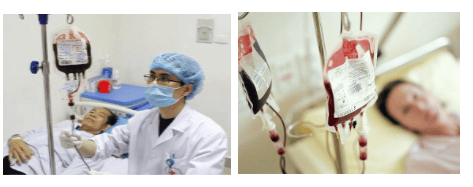
Truyền chế phẩm màu
2. Classification of adverse events related to blood transfusion
2.1. Mechanism of Immune disagreement Infection Mass blood transfusion 2.2. By level: Light, Medium, Severe. 2.3. Over time Acute: An acute transfusion event occurred from the start of the transfusion and within 24 hours of the transfusion. Late: Late transfusion events occur 24 hours to many days after transfusion. 2.3.1. Acute Adverse Reactions Allergic reactions - urticaria Febrile reactions following nonhemolytic blood transfusions Acute hemolytic infections Anaphylactic shock Transfusion Acute Pulmonary Injury (TRALI). 2.3.2. Late complications of blood transfusion a) Transmission of blood-borne diseases
Like HIV-1 and HIV-2, HTLV-1 and II Hepatitis B and C Syphilis, Malaria Cytomegalovirus infection b) Graft disease Transfusion-associated hostility (GvHD)
c) Post-transfusion bleeding
d) Mass transfusion complications
Circulatory overload Hemodynamic disturbances Citrate toxicity Hypothermia Hypothermia Iron infusion.. .
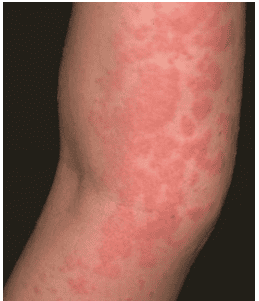
Mày đay
3. Early detection signs and clinical symptoms
Restlessness, anxiety, irritability, lethargy, loss of consciousness Back pain, abdominal pain, headache Fever or chills Papules, rash, urticaria Rapid pulse, low blood pressure, pulse collapse, shortness of breath, respiratory failure Inhalation Nausea, vomiting Sudden bleeding from previously controlled wounds, failure to stop bleeding from new wounds, bleeding that does not clot Hemoglobin...
4. How to handle unwanted blood transfusion-related complications
4.1. General management of acute complications due to blood transfusion 4.1.1. Type 1. Mild reactions Symptoms: Itching, urticaria. Cause: Mild hypersensitivity. Treatment: Reduce infusion rate. Inject an antihistamine. If there is no clinical improvement or deterioration within 30 minutes, treatment should be the same as for a moderate response.
Thuốc kháng sinh Histamin
4.1.2. Category 2. Moderate reactions Symptoms: Itching, hives, fever, chills, tachycardia, mild dyspnea, headache. Cause: Hypersensitivity; Antibodies against BC, TC, proteins. Infected blood bag Management a) Stop infusion, change line and keep IV line.
b) Immediately report the treating doctor and blood bank.
c) Send items, samples, and orders to the blood dispensing lab.
d) Inject antihistamines and antipyretics.
e) Use corticosteroids and bronchodilators if there are signs of anaphylaxis.
f) Collect a 24-hour urine sample for signs of hemolysis.
If the clinical condition improves, a new blood transfusion can be started.
If clinical condition does not improve or worsens within 15 minutes, treat as type 3 reaction.
4.1.3. Category 3. Severe, life-threatening reaction of the patient a) Symptoms: fever, chills, systolic hypotension > 20%, heart rate increase > 20%, hematuria, unexplained bleeding, dyspnea/respiratory failure, angina, back pain.
b) Cause
Acute intravascular hemolysis Blood bag infection and septic shock Circulatory overload Anaphylactic shock Blood transfusion lung injury c) Management
Stop transfusion. Replace the set of wires and maintain the intravenous line with 0.9% NaCl. Infusion of 0.9% NaCL solution (Start 20-30 mL/kg) to maintain maximal blood pressure. If BP is low, infuse rapidly within 5 minutes and raise the patient's leg. Maintain airway and administer oxygen through a mask. Administer Adrenaline (Solution 1: 1000) 0.01 mg/Kg intramuscularly slowly. Administer IV corticosteroids and administer bronchodilators if there are signs of shock. Give an intravenous diuretic (Frusemide 1mg/kg). Report to the treating doctor and Blood Transfusion Department immediately. Send blood bags, samples and request form to the blood distribution laboratory to find the cause. Test a fresh urine sample for signs of Hburia. Collect 24-hour urine and monitor fluid balance.
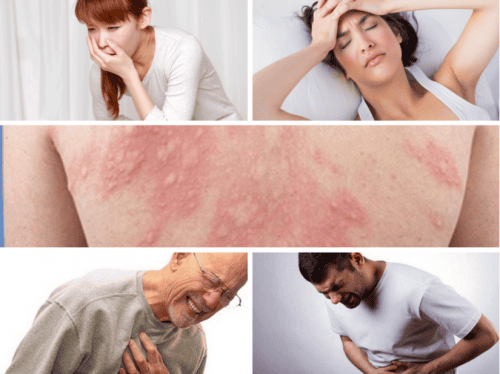
Sốc phản vệ
4.2. Late adverse events due to blood transfusion 4.2.1. Transmission of blood-borne diseases
a) HIV-1 and HTLV-1
Pathogens: HIV-1 infection is currently low because of routine HIV screening (risk about 1/10000-1) /1000000). Infection is mainly seen in the window stage. HTLV-1 infection is mainly found in endemic areas (Japan, Africa...) Clinical manifestations: HIV infection causes AIDS after blood transfusion. Infection with HTLV-1 can cause acute T-cell leukemia or lymphoma. Principles of treatment: There is currently no specific treatment that can achieve cure. Prophylaxis: screening blood donors for HIV and HTLV-1. b) Hepatitis B and C
Clinical manifestations: often hepatitis with no or few manifestations of jaundice. Patients may show signs of fatigue, poor appetite, digestive disorders, joint pain, mild fever... In case of jaundice, clinical manifestations are often more severe. Diagnosis of hepatitis: based on clinical symptoms and specific tests Hepatocellular destruction syndrome such as elevated liver enzymes (SGPT, SGOT) and other biochemical syndromes of liver parenchymal damage.. Principle of treatment: mainly supportive treatment. Prevention: Hepatitis C tends to turn into a chronic form leading to cirrhosis. A smaller number of patients infected with the hepatitis B virus also develop chronic hepatitis and cirrhosis. Therefore, prevention of hepatitis infection through blood transfusion is an urgent issue. Prevention of HBV and HCV infection by donor screening (anti-HCV* and HBsAg). There is no routine screening test for HDV that excludes through HBV screening c) Syphilis
Pathogen: Treponema pallidum. Clinical manifestations: incubation is 4 weeks to 4 months, often presenting as stage 2 of typical syphilis (diffuse skin papules and lymph node involvement). Principles of treatment: common syphilis treatment regimen.. Prophylaxis: syphilis screening test, lowering blood temperature to kill spirochetes. d) Malaria
Pathogens: P. falciparum, P. malariae, P.vivax, P.ovale. Clinical manifestations: the patient has malaria. Principles of treatment: with conventional anti-malarial regimens, there is a good response. Prophylaxis: malaria testing for blood donors for screening. e) Cytomegalovirus (CMV) infection
Clinical manifestations: most patients have no clinical manifestations. Immunocompromised patients may present with viral manifestations such as mononucleosis, CMV pneumonia... Diagnosis: mainly based on serologic markers such as seroconversion with CMV from (-) to (+) after blood transfusion. Principles of treatment: only anti-viral treatment with Ganciclovir and symptomatic treatment when there are clinical manifestations. Prophylaxis: transfusion of blood products from CMV-negative donors to CMV-uninfected patients. 4.2.2. Transfusion-associated graft-versus-host disease (GvHD)
Pathogenesis: Due to the depletion of the T lymphocytes of the donor's blood into the recipient. These lymphocytes react with homologous antigens of the recipient to produce toxic lymphocytes or activate TCD4, producing cytokines that destroy the recipient tissues. Clinical: Fever, digestive disorders, purpura. Treatment: Use immunosuppressive drugs. Prophylaxis: Irradiation into blood bags to inactivate T-lymphocytes.
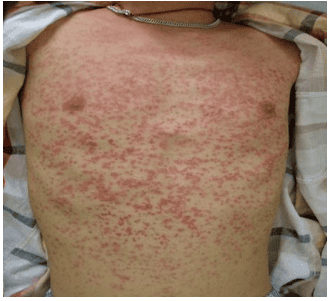
Xuất huyết
4.2.3. Bleeding after blood transfusion: Rare Due to antiplatelet antibodies in the recipient, Bleeding: Platelet count drops rapidly, Treatment: High dose corticosteroids, plasma exchange. 4.2.4. Complications from massive blood transfusions Transfusion of a blood volume/CP equal to body blood volume < 24 hours.
Seen in multiple traumas, stem cell transplants, heart surgery, obstetric complications...
a) Circulatory overload
Pathogenesis: due to rapid transfusion of a large volume of blood, causing circulatory overload especially in patients with pre-existing heart or lung disease. Clinical manifestations: is a manifestation of right heart failure: acute pulmonary edema, cyanosis, dyspnoea... Treatment principles: stop blood transfusion, use diuretics, breathe oxygen... Prophylaxis: no blood transfusion too quickly, especially in patients at risk of circulatory overload such as heart disease, lung disease... b) Hemodynamic disorders
Cause: large volume blood transfusion (MTP, KHC) with little BC, TC, weak coagulation factors should dilute the recipient's blood will reduce TC and clotting factors in the circulation, so it is easy to cause bleeding. Management: Test for platelets and clotting factors to adjust. c) Citrate poisoning
Cause: repeated blood transfusions with anticoagulants containing Citrate, increasing blood citrate, causing calcium reduction, causing cardiac dysfunction. Treatment: Injection/infusion of CaCl2. d) Hypothermia
Cause: Blood stored in cold, when infused in large quantities into the body, lowers body temperature, causing hypocalcemia, decreased oxygen exchange in the organization, causing cardiac arrhythmias, poor prognosis. Management: Blood must be warmed before transfusion. e) Iron contamination due to repeated blood transfusions
Pathogenesis: accumulation of iron in the tissues causes damage to the organ systems infected with iron. Clinical manifestations: clinical manifestations such as darkening of the skin, damage to organ systems, especially the heart, liver, endocrine system... Diagnosis: history of repeated blood transfusions, clinical signs of iron infection and laboratory tests showed increased iron stores in the body. Principles of treatment and prevention: Indication of blood transfusion should be considered, and other treatments such as bone marrow transplantation should be sought for patients with diseases requiring repeated blood transfusions such as thalassemia or bone marrow failure. Use of iron chelation agents to reduce iron infection... Unexpected complications from blood transfusion can occur by different mechanisms,
There are many causes of complications for patients. In blood transfusion,
When transferring blood to a patient, it is necessary to strictly follow the approved guidelines and procedures.
When an accident occurs, it is necessary to handle it promptly and according to the right regimen to ensure patient safety.
Customers can directly go to Vinmec Health system nationwide to visit or contact the hotline here for support.






